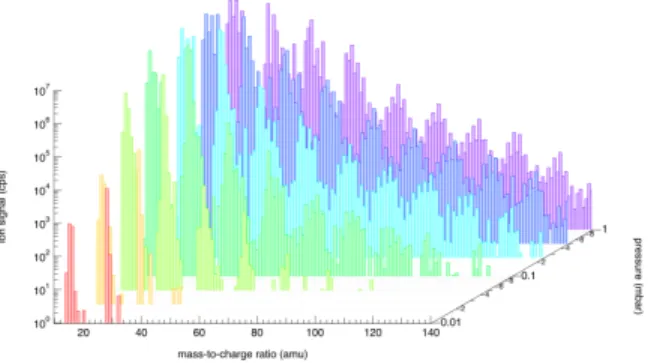HAL Id: insu-02196260
https://hal-insu.archives-ouvertes.fr/insu-02196260
Submitted on 27 Jul 2019
HAL is a multi-disciplinary open access
archive for the deposit and dissemination of
sci-entific research documents, whether they are
pub-lished or not. The documents may come from
teaching and research institutions in France or
abroad, or from public or private research centers.
L’archive ouverte pluridisciplinaire HAL, est
destinée au dépôt et à la diffusion de documents
scientifiques de niveau recherche, publiés ou non,
émanant des établissements d’enseignement et de
recherche français ou étrangers, des laboratoires
publics ou privés.
Gas-Phase Positive Ion Insights during Laboratory EUV
Irradiation of Titan’s Relevant Gas Mixtures
Jérémy Bourgalais, Nathalie Carrasco, Pascal Pernot
To cite this version:
Jérémy Bourgalais, Nathalie Carrasco, Pascal Pernot. Gas-Phase Positive Ion Insights during
Labo-ratory EUV Irradiation of Titan’s Relevant Gas Mixtures. EPSC-DPS Joint Meeting 2019, Sep 2019,
Geneva, Switzerland. pp.EPSC-DPS2019-1337-1. �insu-02196260�
Gas-Phase Positive Ion Insights during Laboratory EUV
Irradiation of Titan’s Relevant Gas Mixtures
Jérémy Bourgalais (1), Nathalie Carrasco (1) and Pascal Pernot (2)
(1) Université Versailles St-Quentin, Sorbonne Université, UPMC Univ. Paris 06, CNRS/INSU, LATMOS-IPSL, 11 boulevard d’Alembert, 78280 Guyancourt, France, (2) Laboratoire de Chimie Physique, CNRS, Univ. Paris-Sud, Université Paris-Saclay, 91405, Orsay, France (jeremy.bourgalais@latmos.ipsl.fr)
Abstract
In the atmosphere of Saturn’s moon Titan, the chem-ical growth is believed to occur through an effi-cient chemical coupling between radicals and reac-tive charged species. However, the role of posireac-tively charged particles in haze formation chemistry is far from being understood. Here, we present a mass spec-trometry investigation with a relatively low pressure interface to chemically characterize the positive ions formed in the pre-haze formation phase starting from the EUV photolysis of N2/CH4gas mixtures.
1. Introduction
Thanks to the discoveries of the Cassini-Huygens mis-sion, it is assumed that the haze formation in Titan’s atmosphere is initiated in the ionosphere, mainly by energetic solar photon dissociating N2 and CH4, the
main components.[1, 2, 3, 4, 5] Heavy ions have been detected including cations up to m/z 99 by the Cassini Ion and Neutral Mass Spectrometer (INMS) at both even and odd masses suggesting positively charged C-and N-bearing species.[6, 7] However, even if they are thought as a key step in haze formation their formation is far from being understood.[2, 4]
In order to better understand Titan’s haze formation, numerous laboratory experiments investigated the gas phase products in the atmosphere of Titan through ir-radiation of N2/CH4 mixtures using various energy
sources (e.g., plasma discharge, electron beam, pho-ton flux) to simulate the molecular growth occurring in Titan’s upper atmosphere.[8] However, commonly used light sources allow to work only above 110nm (Far UltraViolet) which is the dominant energy in the low atmosphere and do not provide sufficient energy to ionize or dissociate N2, essential to understand
ob-served N-incorporation into gas-phase products. It re-quires EUV wavelengths (<110 nm) to address the ef-fect of photoionisation of N2in the upper atmosphere
of Titan. There is only two EUV studies on N2/CH4
gas mixtures using synchrotron radiation [9, 10] in which they showed that N+
2 enhances the formation of
unsaturated hydrocarbons at wavelength below 80nm. Thus, ion chemistry is a potential pathway for nitro-gen incorporation even if there is still a lack of data characterizing ion composition in Titan’s atmosphere simulation experiments.
Thus, our work aims at corroborating the major role, played by the photoionization of nitrogen in the for-mation of complex organic molecules by monitoring ion EUV photoproducts.
2. Experimental Method
Accordingly, here we present the chemical composi-tion of cacomposi-tions produced in the APSIS (Atmospheric Photochemistry SImulated by Synchrotron) reactor during the irradiation at 73.6nm of a methane in nitro-gen gas mixture using an EUV source.[11] The light source used a neon gas flow discharge in the mbar pressure range coupled windowless to the photochem-ical APSIS reactor. In situ mass spectra were taken with a relatively low pressure interface to determine the chemical composition of ions.
3. Results
Figure 1 illustrates mass spectra of cations measured in the APSIS reactor during irradiation at 73.6nm for different pressures, ranging from 10−2to 1mbar. Main
ion species already observed in previous EUV experi-ments are detected such as CH+
5 and C2H+5 along with
an efficient ion production up to m/z 140 at 1mbar. Preliminary analysis allows to believe that the pro-duction comes initially from a dissociative charge-transfer reaction between ionized molecular nitrogen and methane leading to the formation of unsaturated hydrocarbons through subsequent dissociative recom-bination.
EPSC Abstracts
Vol. 13, EPSC-DPS2019-1337-1, 2019 EPSC-DPS Joint Meeting 2019
c
Figure 1: Positive ion mass spectra obtained from N2/CH4 gas mixtures irradiated 73.6nm at different
pressures, ranging from 10−2to 1mbar.
This work will allow to constrain the detailed chem-ical kinetic model by bringing informations about ionic species formed in N-dominated atmospheres. This is important to reduce the sources of uncertainty and/or bias in the model predictions of Titan’s iono-sphere.
Acknowledgements
This research is supported by the ERC Starting Grant PRIMCHEM, grant agreement n°636829.
References
[1] Wahlund, J. E., Galand, M., Müller-Wodarg, I., et al. (2009). Planetary and Space Science, 57(14-15), 1857-1865.
[2] Lavvas, P., Yelle, R. V., Koskinen, T., et al. (2013). Pro-ceedings of the National Academy of Sciences, 110(8), 2729-2734.
[3] Coates, A. J., Wellbrock, A., Lewis, G. R., et al. (2010). Faraday discussions, 147, 293-305.
[4] Waite, J. H., Young, D. T., Cravens, T. E., et al. (2007). Science, 316(5826), 870-875.
[5] Coates, A. J., Crary, F. J., Lewis, G. R., et al. (2007). Geophysical Research Letters, 34(22).
[6] Vuitton, V., Yelle, R. V., & McEwan, M. J. (2007). Icarus, 191(2), 722-742.
[7] Crary, F. J., Magee, B. A., Mandt, K., et al. (2009). Plan-etary and Space Science, 57(14-15), 1847-1856. [8] Cable, M. L., Hörst, S. M., Hodyss, R., et al. (2012).
Chem. Rev, 112(3), 1882-1909.
[9] Imanaka, H., & Smith, M. A. (2009). The Journal of Physical Chemistry A, 113(42), 11187-11194.
[10] Thissen, R., Vuitton, V., Lavvas, P., et al. (2009). The Journal of Physical Chemistry A, 113(42), 11211-11220. [11] Tigrine, S., Carrasco, N., Vettier, L., et al. (2016).
